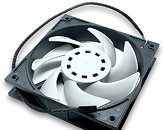Thursday, November 27th 2014

EK Announces Fans Specially Designed for Radiators: EK Vardar Series
EK Water Blocks, Ljubljana based premium computer liquid cooling gear manufacturer, is proud to announce company's first fully in-house engineered computer cooling fan, designed and built primarily for highest-performance computer liquid cooling systems - the EK-Vardar. This product is the result of one year worth of development, CFD analysis, careful motor selection and anechoic chamber testing.
Dubbed Vardar, this family of cooling fans carry the name of a type of the cold northwesterly wind blowing from the mountains down to the valleys of Macedonia. It is a type of ravine wind, enhanced by a channelling effect while blowing down through the Moravia-Vardar gap, bringing cold conditions from the north to the Thessaloniki area of Greece. Most frequent during winter, it is blowing in the rear of a depression when atmospheric pressure over eastern Europe is higher than over the Aegean Sea."High-pressure fan design have distinct blade characteristics", said Vlado Schweiger, chief hydrodynamic engineer at EK Water Blocks. "The key task was to optimize noise profile throughout entire fan operational range."
The key characteristics of EK-Vardar Fx-120 series fans are:
Dubbed Vardar, this family of cooling fans carry the name of a type of the cold northwesterly wind blowing from the mountains down to the valleys of Macedonia. It is a type of ravine wind, enhanced by a channelling effect while blowing down through the Moravia-Vardar gap, bringing cold conditions from the north to the Thessaloniki area of Greece. Most frequent during winter, it is blowing in the rear of a depression when atmospheric pressure over eastern Europe is higher than over the Aegean Sea."High-pressure fan design have distinct blade characteristics", said Vlado Schweiger, chief hydrodynamic engineer at EK Water Blocks. "The key task was to optimize noise profile throughout entire fan operational range."
The key characteristics of EK-Vardar Fx-120 series fans are:
- High-static pressure / low noise profile - unlike other general-purpose computer cooling fans, the EK-Vardar family of fans is built specifically for computer liquid cooling systems, namely radiator cooling. The 7-fin fan blade design is optimized for high pressure operation while maintaining the low noise profile throughout the whole operation range of the fan.
- High-quality motor and bearing assembly - Proven electrical design, actively cooled motor windings and Double Ball bearing with 50.000 hours lifespan (MTBF) ensures uninterrupted operation for years to come. Phase-width modulation (PWM) fan speed allows performance on demand.
- Sealed-edge fan casing - The classic, yet effective square shape of the fan casing ensures optimal performance in either pull- (suction) or push (pressure) regime without hydraulic losses thus ensuring optimal cooling capacity of your liquid cooling radiators.
- Timeless design - the EK-Vardar fan fits subtly into any liquid cooling computer without drawing too much attention. Single- and two-tone colour design with monochrome fan sticker. Less is more.




17 Comments on EK Announces Fans Specially Designed for Radiators: EK Vardar Series
This is just one more product that EK will be flooding news sites with press releases for from now on.
I still have an old 120mm GT. Love that thing. =)
it has been discontinued for 3.11 earthquake.
that is good news.
Though we have a lot of "Radiator ready" fans already on the market but I am always ready to see some "new" contenders.
No metal hub,
Missing 2 blades,
Larger gap between blade and housing,
Non-composite plasic,
and GT's never did PWM....
Im not saying these cant be good fan's, just dont make the mistake of thinking you're purchasing a set of Typhoons.
For all we know EK may have private labeled their new fans through Nidec Servo to their specifications. Gotta love OEM's and the private labeling industry.
Source: Overclock.net
Source: Overclockers.com
Source: Nidec Servo Data Sheet
Just for fun: Did you know EK, Alphacool, Swiftech and many other Water-cooling manufacturers use Magicool as their OEM for radiators?
*Drops the MIC*
I thought i erased the PWM comment, guess not.... the rest is true though... It's not nidec....
furthermore i find it odd that they claim a "high static presure....." but dont list the specs...
suspicious
ps.. please try to be less insulting.... EVERYBODY has "a lot to learn"
Note that this is a pre-production sample, but I couldn't resist requesting one for the sponsored build in the TX10-D. The packaging is finalized and tells you exactly what fan it is (the F4 in this case) and also the maximum fan RPM.
On the back we get tech specs and also the P-Q curve which, as others have seen, is similar to that of the respective Gentle Typhoon fan.
Nothing new on the side, and we see the contribution from Slovenia and the manufacturing company in China listed out here.
As I said this is a pre-production sample, and so there was only the fan in here. The final versions should come with 4 self-tapping screws and a few other cosmetic improvements. But enough about all this, let's take a look at the actual item:
As I said, cosmetic improvements incoming :p
I believe the heatshrink is getting a makeover and the label on the back of the hub will be done, not 100% sure about the retail sample sleeving material but I will likely buy a few anyway.
The advertized specs list a PWM duty cycle of 40-100%, but I was able to get it to as low as 20% on a single fan. The RPM response curve is mostly linear, especially from 25-95% where I suspect most people will be running this at anyway. Noise levels aren't the lowest I have seen at a particular fan RPM but when adding in the airflow through a radiator (a 11 FPI, 30mm thick 120mm radiator in push orientation), things get very impressive. As always, measurements were done 6" away from the fan to minimize background effects and also get the measurements in the >95% confidence range of measurement of the instruments used.
Here's how the GT AP-45 and eLoop B12-4 stack up (having removed the Swiftech Helix120 owing to potential uncontrolled variables and re-plotted as requested):
I will say that the AP-45 was not at it's best from 9-11 V here with an unpleasant buzz that I could hear in the open- not necessarily an issue inside a case a few feet away. But you can see that while the AP-45 and Vardar F4 are very identical in airflow through the radiator, the Vardar F4 is slightly quieter most of the time. The eLoop B12-4 needs a lot more fan speed to hit the same levels of airflow as the other two, and with it comes more noise. Another thing I will point out is that I was able to get the AP-45 all the way down to 186 RPM at 2V without issues, but at that point the airflow was lower than the reliable detection limits of the anemometer. Needless to say I am going to get a few more of these for the TX10-D radiators, and will test out the other NB eLoops also soon.